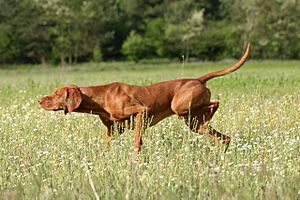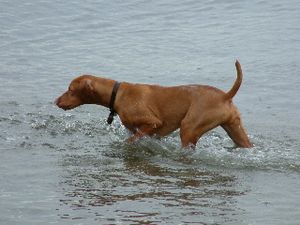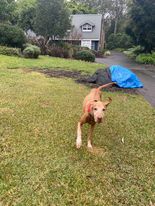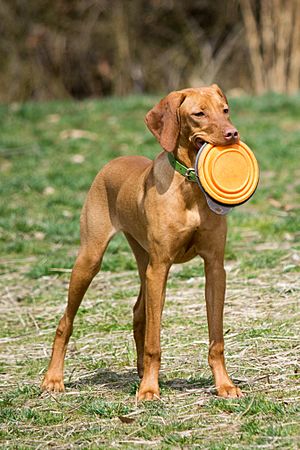Vizsla facts for kids
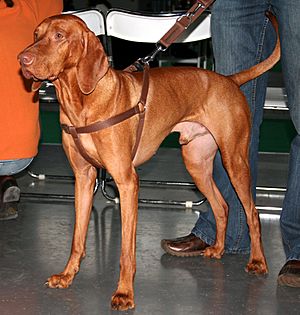 |
|||||||||||||||||
| Origin | Hungary | ||||||||||||||||
|---|---|---|---|---|---|---|---|---|---|---|---|---|---|---|---|---|---|
|
|||||||||||||||||
|
|||||||||||||||||
| Domestic dog (Canis lupus familiaris) | |||||||||||||||||
The Vizsla is a special dog breed from Hungary. People often call them the Hungarian Vizsla or Smooth-Haired Vizsla. They are known as sporting dogs, which means they are great at activities like hunting. Vizslas are also very loyal and make wonderful family pets. Their medium size is one of the things people love most about them. These dogs are excellent hunters, especially for birds and other small game. They are also loving companions in the home.
Vizslas are natural hunters with a fantastic sense of smell. They are also very easy to train. They were originally bred to work in fields, forests, and even water. Even though they are lively and brave, they are also gentle and very loving. They form strong bonds with their families and have a good instinct to protect them.
Contents
Discover the Vizsla: Appearance and Traits
What Does a Vizsla Look Like?
A Vizsla is a short-haired hunting dog with a very elegant look. They are strong but not heavily built. Vizslas are lean dogs with clear, strong muscles.
Sometimes, people confuse Vizslas with other dog breeds. These include Redbone Coonhounds, Weimaraners, and Rhodesian Ridgebacks. Vizslas look similar in body shape to Weimaraners and Redbone Coonhounds. However, Vizslas are usually leaner and have more defined muscles. Weimaraners and Rhodesian Ridgebacks are also generally bigger than Vizslas.
A Vizsla's nose will always be reddish, matching its coat color. If a dog has a black, brown, or pink nose, it's likely not a purebred Vizsla. Their eye and nail colors should also match their coat.
Vizsla Colors and Coats
The usual coat color is a French-row yellow, which comes in different shades. You might also describe it as a yellow, copper-brown, russet gold, or dark sandy gold. Solid dark red or very pale yellow coats are not considered standard. Small white patches on the chest, neck, or tail are allowed but not preferred. Some Vizslas might have slight color changes along their back, which is normal.
The American Kennel Club (AKC) says a Vizsla's coat should be short, smooth, and thick. It should lie close to their body and not have a woolly undercoat. Because they lack an undercoat, Vizslas are not suited to live outside in cold weather. They are also known as "self-cleaning" dogs and rarely need baths. They don't have a strong "dog smell" that humans can notice. If they swim a lot, they might get a faint wet dog smell, but a quick bath will make it disappear.
How Big Do Vizslas Get?
Vizslas are medium-sized dogs. Here are their average heights and weights:
- Males
- Height: 23–27 in (58–69 cm)
- Weight: 45–66 lb (20–30 kg)
- Females
- Height: 21–24 in (53–61 cm)
- Weight: 40–55 lb (18–25 kg)
Vizsla Tails
A Vizsla holds its tail straight out, level with the ground. They wag it with lots of energy when running through bushes and thick plants.
In some places, a Vizsla's tail is traditionally shortened when they are very young. This is called "docking." However, many animal health groups, like the American Veterinary Medical Association, are against tail docking for cosmetic reasons. In the UK, some laws allow docking for working dogs but not for pets. A Vizsla's docked tail is usually longer than that of some other breeds like Weimaraners or Dobermanns.
Vizsla Personality: "Velcro Dogs"
Vizslas are very energetic, gentle, loyal, and loving dogs. They quickly become very close to their owners, children, and even new people. They are often called "velcro" dogs because they love to stick close to their human family. If a Vizsla feels ignored or unhappy, they might cry or whine. Some will bark at strangers if they feel their family's space is being invaded. With the right training, they can be good guard dogs.
They are natural hunters and learn very quickly. Vizslas are not only great at pointing out game, but they are also excellent at retrieving it. They will fetch things on land and in water, using their natural instincts. It's important to train them gently, without harsh commands. They have sensitive personalities and can be easily upset if trained too roughly. However, their owner needs to be calm and firm, or the dog might try to take charge of the training!
Vizslas need lots of attention, exercise, and playtime. They are smart dogs and need plenty of mental challenges, especially when they are young. If left alone for too long, they can get bored and might become destructive. With good training and meeting new people and places, Vizslas are very gentle dogs. They can be wonderful with children. A Vizsla always wants to be near its owner. Many Vizslas even like to sleep under the covers in their owner's bed at night!
Vizsla Health and Lifespan
The American Kennel Club says a Vizsla usually lives between 12 and 14 years. However, a 2008 survey found the average lifespan was about 9 years. Vizslas are generally strong dogs. But some breeding programs, especially those using only a few dogs, have led to certain health problems that can be passed down. These include:
- Hip dysplasia: This is rare but possible.
- Canine epilepsy: A brain disorder that can cause seizures.
- Cancer: Such as mast cell tumors or lymphoma.
- Sebaceous adenitis: A skin condition.
Good breeders make sure not to breed dogs that have these inherited problems. Vizslas can also sometimes have other issues like hypothyroidism (a thyroid problem) or allergies.
The Vizsla's Long History
The first time the Vizsla dog breed was written about was in a book called the Illustrated Vienna Chronicle in 1357. This book was made for King Louis I of Hungary.
The Vizsla breed has survived many tough times in history. These include the Turkish rule (1526–1696), wars, and even World War I and World War II. After World War II, the breed almost disappeared. People searched all over Hungary and found only about a dozen true Vizslas left. From this small group, the breed grew strong again. Different types of Vizslas developed as breeders chose dogs that fit their hunting styles. Outside of Hungary, Vizslas were also commonly bred in Romania, Austria, Slovakia, and Serbia.
Vizslas began to arrive in the United States after World War II. As more people became interested in them, owners created the Vizsla Club of America. Their goal was to get the breed officially recognized by the AKC. On November 25, 1960, the Vizsla became the 115th breed recognized by the AKC.
The Vizsla breed was also used to help create other dog breeds. These include the Weimaraner, the Wirehaired Vizsla, and the German Shorthaired Pointer. It's also thought that some of these other pointer breeds were used to help bring the Vizsla back from near extinction in the late 1800s.
Vizslas in the UK
About 4,520 Vizsla puppies are registered with the Kennel Club of Great Britain each year. This makes them one of the top 50 most popular dog breeds there. Their popularity is growing as more people discover this wonderful breed. There are two main clubs for Vizslas in Britain: The Hungarian Vizsla Club and The Hungarian Vizsla Society. A Vizsla named Hungargunn Bear It'n Mind even won the "Best In Show" award at Crufts in 2010, which is a very famous dog show!
See also
 In Spanish: Vizsla para niños
In Spanish: Vizsla para niños
- Dogs portal
- List of dog breeds
- National symbols of Hungary
- Wirehaired Vizsla, a breed created by mixing Vizslas with German Wirehaired Pointers.
- Hungarian dog breeds



